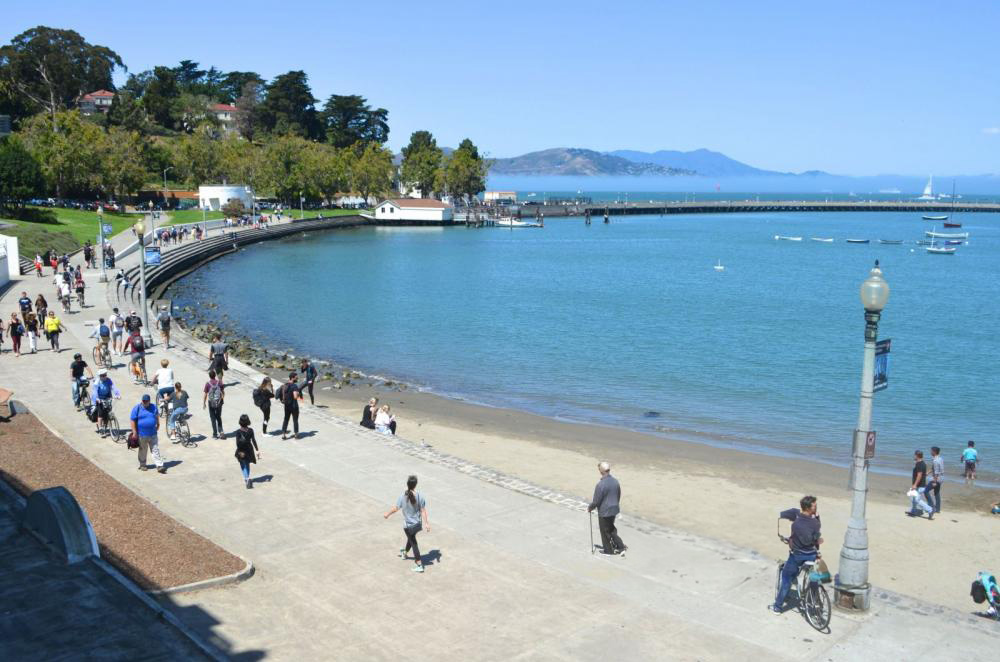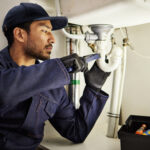Businesses – small and large – play an important role in reducing pollution in the San Francisco Bay. Just like residents, business owners and employees are responsible for ensuring their actions do not negatively impact water quality. Explore the resources below to help your business protect the Bay.
What Happens To Water Down the Drain?
Businesses create wastewater through their daily practices. This water from sinks, hoses, laundry, etc flows through sewers to a wastewater treatment facility where it is cleaned before being discharged into the Bay. This system of pipes, sewers, and treatment facilities make up the clean water infrastructure that provides these essential services to the more than 7.7 million people living in the Bay Area. The public pays rates to their local clean water agency to support the processes and machinery that make this possible.
The Bay Area has over forty wastewater treatment facilities and more than 16,000 miles of sewer pipes that discharge billions of gallons of treated water per year into the San Francisco Bay. Wastewater treatment facilities use a variety of treatment technologies to clean water, similar to processes in nature. All facilities must meet robust, science-based standards that are set by state and local regulators.
Why Does it Matter?
Clean water infrastructure is the foundation of the modern city we know today. Without this essential service, raw sewage from all of our homes and businesses would flow into our waterways and the Bay, polluting this vital natural resource and resulting in unlivable conditions.
Keeping our communities safe and the San Francisco Bay clean and healthy is crucial for human health, ecological balance, economic prosperity, and climate resilience.
- Human Health: The treatment of wastewater keeps the Bay, waterways, and air clean, reducing the risk of pollution-related health issues for residents and visitors.
- Ecological Balance: The Bay is home to diverse plant and animal species, and a clean environment ensures their survival and maintains the overall ecological balance.
- Economic Prosperity: A clean Bay and functioning sewer system is crucial to all commercial activities including trade, fishing, and tourism. Clean water infrastructure supports economic prosperity in the region.
- Climate Resilience: A healthy Bay with intact wetlands and marshes acts as a natural buffer against storms, flooding, and sea-level rise, helping to protect coastal communities.

How Does it Work?
The highly skilled public-sector employees who work in clean water infrastructure care deeply about the health of the Bay and the people who live in the Bay Area – they live here, too! These scientists, engineers, and other professionals are environmentalists that are guided by cutting edge science in their decision-making, ensuring they are maintaining the quality of the San Francisco Bay for all of us while keeping customers rates low.
While exact processes vary from facility to facility the general steps of the treatment process are the same.
Collection Systems
When you flush a toilet, wash your dishes, or take a shower, that wastewater flows through a collection system of underground pipes (sewers) to a wastewater treatment facility.
Treatment Facility
After flowing through a collection system, wastewater reaches a wastewater treatment facility, where it is cleaned (or “treated”) using a three step treatment process.
- Physical (Primary Treatment) – big screens catch and remove large items like rags, wipes, pieces of wood
- Biological (Secondary Treatment) – uses good bacteria or “bugs” to remove pollutants
- Chemical (Disinfection) – adds chemicals, like chlorine, to the water to ensure water is safe for animals and the Bay. Chemicals are removed or diluted to appropriate levels before discharge.
Discharge
After treatment, the cleaned wastewater can be safely released into a local waterway, such as a river, groundwater basin, San Francisco Bay, or the Pacific Ocean. It can also be recycled and reused for many different purposes, such as industrial uses, irrigation, groundwater recharge, or even drinking water, depending on the level of treatment.
Click on the resources below to see more details about how these regions clean wastewater.
- StoryMaps of East Bay Municipal Utility District
- Video of Oro Loma Sanitary District
- Virtual Tour of Central Contra Costa Sanitary District
What’s My Role?
The complex system of pipes, pumps, and large-scale machinery that makes up the clean water infrastructure in the Bay Area totals billions in assets and is infrastructure that is owned by all of us and is maintained through the payment of rates.
Your daily actions matter! Everyone who uses water, from individuals to commercial businesses, has a role to play in maintaining our clean water infrastructure by following guidelines like never flushing wipes or other trash, following regulations specific to your business, and responsibly disposing of hazardous materials. Explore the resources throughout this website to learn about how you can help keep our Bay healthy and clean.





